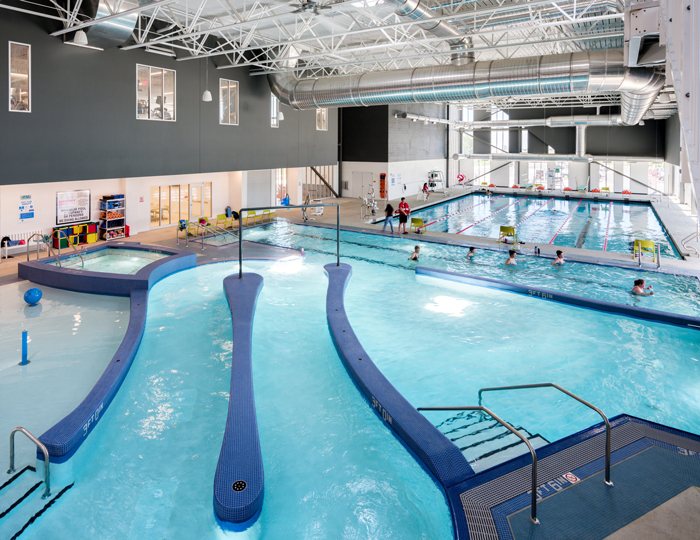If you asked everyone who walked through the doors of your local indoor aquatic center what they were doing there, you’d most likely get a variety of answers. Maybe they’re lap swimming for exercise; participating in a water polo game or swim/dive competition; getting some therapy for an injury; taking a swim lesson or water aerobics class; trying out the newest waterslide, obstacle course or surf attraction; learning to scuba dive; or simply floating relaxingly on a lazy river. Natatoriums offer many reasons to visit, and pool designers and operators have many considerations when it comes to planning how best to use their spaces and budgets.
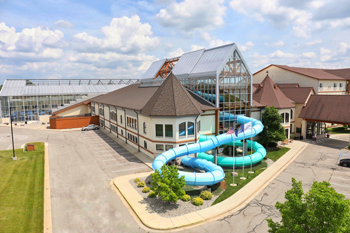
“Essentially any programming is going to maximize user participation,” according to Jen Gerber, vice president, strategic partnerships and operations at Water Technology Inc. “Whether this is through special exercise classes, competition and training by local swim clubs or the use of floatables in a competition pool, the more activities available, the better the odds of maximizing user participation and offsetting operational expenses by generating revenue.”
She said they continue to see demand for multigenerational facilities, “specifically designed to attract the entire family and satisfy the needs of the community. Being able to engage multiple user groups is key to increasing participation, interest and revenue.”
Maximizing revenues and managing costs for both capital and operational expenditures is a key focus for operators, according to Lauren Ozburn, aquatics consultant and project manager with Waters Edge Aquatic Design, who added that determining goals during the planning phase can lead to operational success. “Having a pool space that allows for flexibility and multiple uses in the same body of water can assist in designing an efficient facility.”
Natatorium design much be flexible in order to serve a wide array of programs, agreed Justin Caron, principal and CEO of Aquatic Design Group. “Water that is used for a competition swim team one hour may be used for recreation or swim lessons another. Spaces, pools and configurations must be designed to allow for multiple programs and uses to achieve a maximum utility and revenue potential for a facility resulting in mixed use facilities,” he said.
“Mixed use facilities require much more planning and forethought than a single use facility such as a competition pool,” he continued. “Variables such as water temperature, water depth and pool configuration are all part of the pre-planning process. Planning must consider not only the multiple programs a facility is to support but also simultaneous programs as well. With the correct planning and construction, a facility can keep people and programs in the water all day long, which is key to a maximum operating cost recovery.
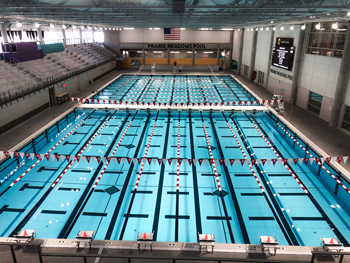
“Staffing is also a strong consideration in these types of facilities. For example, a facility that will have lifeguards and constant supervision can stretch the limits in programming and amenities. Facilities that do not expect to have such staffing will be required to have a simpler design. Successful facilities can cater to the program needs of the entire community.”
Ozburn said it’s important to know who will use the facility and how, and then design in a way that maximizes use while being efficient with the space size; as the space gets larger, so do costs and the level of resources needed. “With personnel expenditures taking up around 60% on average of an expenditure budget, this is typically a key point for assessment and consideration.”
And while Ozburn pointed out that indoor pools are excellent sources of activity throughout the year, they typically do come with expanded costs and demand for resources. “Indoor pools can vary in character and primary service function, so determining what primary and secondary uses will be is important during planning so as not to oversize a particular area, for example, kids’ spaces, lap lanes, etc.”
She listed some key questions to consider: To what degree will swim or dive teams utilize the facility? Is the intent to have recreational space for children and families? Do you desire a comprehensive program schedule, including lap swimming, fitness, swim lessons, special use programming, etc., and what might their schedules be? Is there an expectation to have rentals, birthday parties and special events?
For those facilities that do wish to offer comprehensive program schedules, the utilization of multiple bodies of water is still a popular choice. When going this route, Gerber spelled out a few of the important design considerations: water temperatures and depths; layout and integration—or separation—of multiple pools; acoustical treatments; and operational impacts. “Best practices would be to have each pool on its own mechanical system to increase the operational viability of the facility.”
Gerber pointed to a project in Canada—at the University of British Columbia—to illustrate how a facility can successfully integrate multiple programs all under one roof, as it’s designed with “two distinct but harmonious zones. One zone houses the 10-lane, 51-meter competition pool that hosts FINA and NCAA aquatic events and training, while the community side—separated by a thoughtfully designed bench structure—features a blend of lap, leisure and hydrotherapy. Weaving these amenities together provides programming flexibility and meets the needs of the varied users at the university.”
David Keim is director, public market business development, at Aquatic Development Group, and while he agreed that offering multiple bodies of water is a common design choice, he described other strategies for achieving multi-use status. “With construction costs continuing to escalate and facilities demanding variable programming, bulkheads and moveable floors provide a means to conduct multiple programs in a single pool, while eliminating the costs attached to constructing multiple pools. In an indoor setting, eliminating the need for multiple pools also translates to a reduction in the size of the natatorium enclosure, further reducing construction costs.”
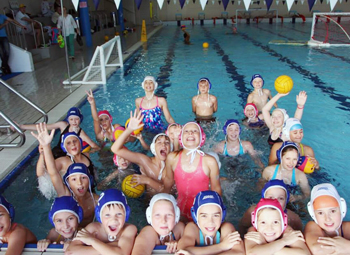
“Single multiple use pools were developed to provide a smaller footprint for indoor pools given the expense of a natatorium building,” Caron explained. “Creating zones that can serve multiple programs in a single pool allows for a smaller building. The disadvantage of this approach is that it can make staffing and supervision more difficult. A single pool will provide a single water temperature. Competitive water requires cooler water temperatures, typically 78 to 82 degrees, while recreation, learn-to-swim, and therapy pools require warmer water temperatures, typically 82 to 90 degrees. By having multiple smaller pools, the water temperature and pool configurations are better suited to specific programs. With multiple smaller pools a facility can close one or more of the pools if programming has less demand during certain times of the year. Since staffing is the single largest ongoing expense for facilities this can reduce annual operating expenses and provide a better operating cost recovery.”
With indoor pools, Keim pointed out that another key factor in making design decisions is air quality, and he said the bottom line continues to be controlling humidity, temperature and chloramines. “Whether through dehumidification, UV disinfection, exchanging air or using a combination of these technologies, proper air quality is important to the overall comfort and safety of guests, athletes and staff members.”
“Modern natatorium design focuses on quality. Quality of air, water and spaces,” Caron said. “Better air and water quality mean a healthier atmosphere for patrons and employees. As patrons have more frequent visits with longer stays when at a natatorium the actual and perceived health and wellness of a facility is in greater demand. To achieve this, engineers are turning to integrated computerized controls that monitor and manage the air and water systems. These systems have the capability of adjusting conditions based on bather use and other environmental conditions. Rather than a single disinfectant, chlorine for example, these systems use both a primary and a secondary disinfection system. The secondary disinfection is often ultraviolet or ozone disinfection systems. When managed correctly they can provide better air and water quality in the natatorium. Another trend is to oversize the systems to allow them greater turnover of the air and water circulation and filtration systems. During peak loads the systems can increase the turnover and filtration of the water and air systems to maintain a quality chemical free environment.”
“New advancements in source capture technology have transformed the experience for athletes and spectators alike,” said Gerber. She explained how chloramines form in the water as chlorine combines with ammonia and nitrogen, and then off-gasses into the air, giving off a strong odor. She described a chloramine removal system patented by a South Carolina-based pool equipment company, and said that by utilizing this technology, either in the gutter system or on the pool deck, “the most harmful and corrosive fumes are pulled right off the surface of the water and exhausted out of the facility, rather than circulating through the entire natatorium for HVAC treatment.”
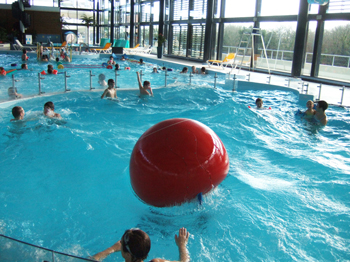
In Iowa, Ozburn’s company helped develop an aquatic facility for the student recreation center at the Des Moines Area Community College. Programming was a major consideration, and the final product included both competition and recreation areas that focused on maximizing space. There were even plans to integrate academic programs into the facility such as early childhood management and sport and physical therapy management. The competitive pool features eight 25-yard lanes, easy access stair entry and one-meter diving. Spectator bleachers are permanently fixed to the pool deck. A small therapy/wellness pool with ADA access features swim current jets and an underwater treadmill. The rec pool has a zero-depth entry ramp versus full zero-depth entry, to maximize deck space and provide deeper water for wellness aerobics and open swim. There are two lap lanes, floatables, volleyball and basketball. The pool can be used by the public during swim meets and practice, and is used as a warm-up/cool-down area during competitive events. A glazed curtain wall provides integrated solar energy-saving measures, and the ability to manage the air and water temperature of both spaces efficiently. Heat from the building HVAC is reclaimed and utilized to heat the pools, and high-efficiency heaters help provide additional support as needed.
When it comes to sustainable features, Ozburn said that if a facility is seeking LEED status, extra attention will be given to a more sustainable design. But even if the LEED rating system is not a priority, “there are still alternatives available that provide the benefits of sustainability, and this is a common category for communities to be in. Exploring capital and operational costs, sustainability goals and operating considerations will help identify which energy efficiency options are a best fit for the project.”
For instance, she said that when deciding on mechanical and water filtering systems, comparing the cost of equipment with its water and energy use versus its life expectancy is an exercise to work through. Facilities may decide that they’re comfortable spending more up front on high-efficiency items based on cost considerations and ongoing utility usage. And she listed some other areas for consideration, including durability and quality of materials; appropriate filter, pipe and pump sizing; enhanced systems and controls to extend facility life and reduce maintenance; alternative regenerative filter systems; reclamation of heat for indoor spaces; and disinfection systems such as UV.
Gerber pointed out that another key consideration in efficient mechanical and filtration equipment is the reduced impact on staff. “Systems that are easy to maintain make it easier for staff to service, and reduce the learning curve during staffing turnover.”
And as for choosing pool features from the myriad of options, budgets, flexibility and available space must be considered, to get the most bang for your buck. “Designing for occupancy by offering diverse amenities is an operationally efficient way to serve multiple user groups with just one amenity,” said Gerber. “For example, current channels and lazy rivers can be used for resistive or assistive training during one time of the day, and then can serve as a recreational river at a different time of day.”

Gerber also mentioned wave generation technologies as continuing to gain traction. Keim’s company manufactures a popular surf ride, and he said that bigger, waterpark-style amenities are showing up at all types of aquatics facilities now, and not just outdoors. “Wave pools, surf attractions, lazy and action rivers, iconic slide complexes and multi-level play structures, among other attractions, are increasingly finding their way into designs for indoor facilities.”
Another attraction continuing to gain popularity is the aquatic challenge or obstacle course. Kyle Rieger is managing partner of an Overland Park, Kan.-based dealer of a retractable obstacle course system inspired by the American Ninja Warrior TV series. Facilities use the courses for recreation, fitness, training, therapy and competition, sometimes hosting leagues and tournaments. Depending on a clients’ desired cost recovery, the courses may be free or admission-based, according to Rieger. “The best opportunity for owners to generate revenue is sponsors, donors and naming rights opportunities. There are four large, custom-printed signs (two on each end of the frame) where a local business or organization can locate their name.”
Rieger mentioned some upcoming installations, including one opening this summer at the new Idaho Fieldhouse, the headquarters for the Challenged Athletes Foundation and Mission43, which assists veterans and their spouses. “This system is truly accessible to all ages and abilities.” And they’re anticipating their first university installation, part of an expansion for the University of South Dakota, “where we’ll install over a 50-meter pool used by Athletics, Campus Rec and the local community. The owner and design team designed infrastructure so that we could phase in a second system in the future.” The systems can be retrofitted to existing facilities or designed into new ones with relatively minimal ceiling loads.
In fact, many colleges and universities offer indoor aquatics for their students and student athletes. And sometimes, as with K-12 schools, the facilities are also available for community use, though this practice varies, according to Keim. “Often school and college pools are so heavily programmed with training, competition and PE programs that there simply isn’t enough time available for the surrounding community.” Aquatic facilities can also drive enrollment at the college level. “In the competition swimming and diving communities, recruiting is a very big deal,” said Keim. “The quality of the aquatic facilities available can have a major influence on an athlete’s school choice.”
As far as trends in the college market, Gerber said that moveable bulkheads and floors are very popular as they “increase the amount of flexible, programmable space, allowing facilities to maintain several activities at once, such as competition and water polo with minimal to no disturbances in the water. These features can make one body of water function like multiple pools.”
Additionally, there’s the opportunity to achieve two temperatures in one body of water, “the ultimate in programming flexibility for operators and users. The University of Wisconsin had a moveable floor that was installed recently after the project was completed and they’ve been extremely happy with the performance of the feature.”
When it comes to trends in aquatic facilities at K-12 schools, Gerber pointed out that water polo is a rapidly growing aquatic sport, largely credited to “the focus on additional play opportunities and the growth and development of the Olympic offerings. Whether we’re working on new or renovated facilities, water polo is part of the conversation, and almost always part of the design in institutional facilities. Schools are responding to the growth in the sport by ensuring that their facilities can provide the necessary accommodations.”
Renovations of existing spaces are common, with facilities looking to update amenities, follow programming trends, modernize mechanical systems and more.
Ozburn’s firm conducts facility evaluations to help venues prioritize their updates, and she shared some items that they commonly look at. “Each facility is different, and the age of the facility, maintenance and care practices, changing community needs and budgetary constraints all contribute to identifying the need for improvements. Common upgrades include filter and mechanical equipment replacements, underground piping and main drain repair or replacement, gutter replacement and chemical controller replacement. These are common in facilities 20 to 30-plus years of age.”
Sometimes—as with other types of amenities and programs—it can be advantageous to engage those who use the facility when deciding which updates or additions to prioritize, and Ozburn said that while user feedback is indeed of interest, an organized, consistent and accessible program for collecting data should be developed. “We see that successful feedback collection comes when there is a concentrated effort in developing a relationship between staff and the community, and that feedback is regularly reviewed and assessed, and follow-up and action is taken based on feedback.”
Tastes change, programming trends come and go and new technologies are always emerging. Therefore, it is important for designers and operators of natatoriums to stay current on ever-evolving trends. “There are numerous aquatic facilities that offer modern and exciting amenities,” said Ozburn. “Some of those amenities and features are now expected offerings, such as zero-depth entries, moving water and large waterslides. Although we hear about them as being of interest, there are other areas that are starting to become key conversation points.” RM



